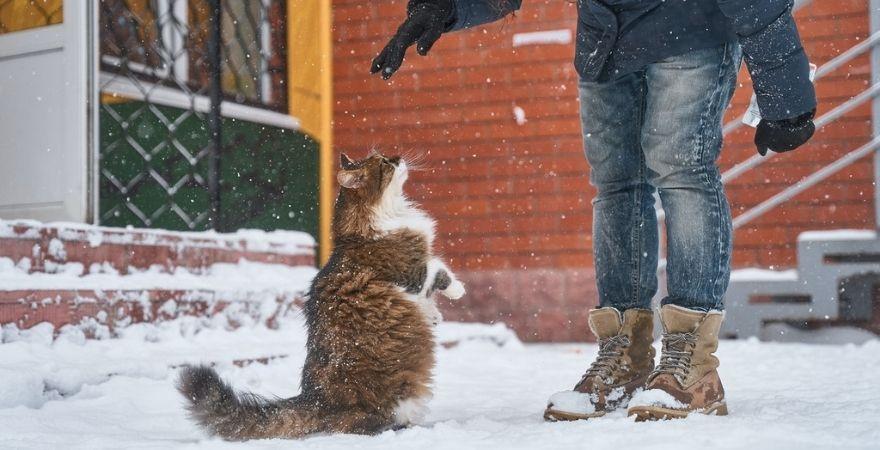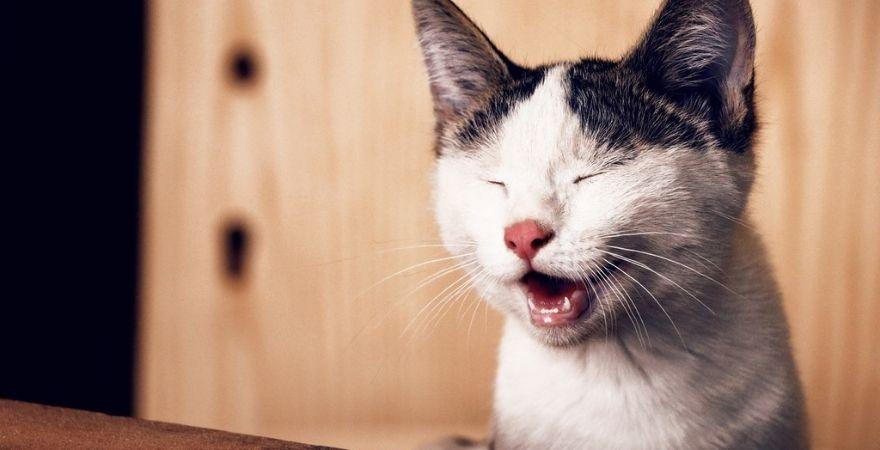You can feed two cats the same quantity and one will put weight on and the other will lose! This is because cats burn calories at different rates, just like people. But don’t despair, there is an easy way to work out how much should I feed my cat and it's called Body Condition Scoring.
To get started use the feeding guide recommendation on the pack. Let’s say Kitty weighs 10 lbs, so start by offering the amount the manufacturer suggests. But, first take a long hard look (and feel) of Kitty. Ask yourself
- Where is her waistline: She should have a nipped in waist when viewed from the side and from above
- Can I feel her ribs: Are you able to easily feel her ribs with only gentle pressure (which is the ideal)
- Likewise can you feel her backbone and pelvis, but without the bones staring out through the cat (again, the ideal)
- Is her head in proportion to her body? Hint, a head that looks too small for the body is usually because the cat is overweight
Each week, do the same checks. If her ribs become more difficult to feel, she’s put weight on and she needs less to eat. Cut her ration by 5 - 10 %. However, if she’s lost weight and her ribs are visible then increase her ration by 5 - 10%. Repeat this week by week and you’ll soon find the answer to how much should I feed my cat.

Mistakes People Make Feeding Cats
The biggest mistake people make when feeding cats is to mistake Kitty’s affection for hunger.
What does this mean?
OK, imagine Kitty rubbing round your ankles in the kitchen, purring like a steam train. Many owners interpret this as their fur friend feeling hungry...when in fact they want attention. At first the extra food comes as a nice surprise, but then she learns to expect it. Then when the treats don’t appear she gets quite shouty until you give in. But in fact Kitty isn’t hungry but has learned this role play follows this pattern and is a great way of getting her owner’s undivided attention.
So instead of reaching for the treats, give her chin a rub or spend time playing or grooming her.
Another mistake is to make eating too easy by leaving a full bowl down all day. A feral cat has to work hard to hunt her supper, but a house cat just has to pad across the kitchen floor. Not only that but eating becomes a comfort activity if the cat is bored (again, she’s not actually hungry.) Instead, make mealtimes into an activity that provides wonderful mental and physical stimulation.
Simple tricks such as using puzzle feeders (you can make your own from muffin tins or even cardboard tubes) or hiding small amounts of food around the room, make all the difference. This let’s Kitty exercise her inner predator to hunt down her dinner, which is much more satisfying for her and cuts down on boredom snacking.
Factors That Affect How Much to Feed a Cat
Sit down to dinner and no two people eat the same amount. Cats are just the same, which each having different nutritional needs (it’s not just about calories!) depending on factors such as how old they are, whether they’re desexed or entire, male or female, and whether they’re a couch potato or super-active.
For example, a desexed cats burns around 5% fewer calories than the exact same cat when they were entire. So once Kitty is neutered, it’s wise to cut her portion by 5% in order to keep the same svelte waistline.
It’s no surprise that an active cat requires more calories than a lazy one, but this also applies to age as well. A playful kitten uses more energy than a sedate senior, and what suites one doesn’t suite the other.

The Best Type of Food
Every owner has their preferences when it comes to feeding. What to feed a cat is an individual decision, and opinions vary between people. My personal preference is to steer away from raw foods (a whole article in itself) and go for a good quality complete diet. When I choose a food, these are the rules I apply.
- Choose a life stage diet: It sounds obvious but kitten food is for kittens, and senior food for the 8-year olds and over. This is because they are nutritionally balanced for the needs of these age groups. Avoid a “one size fits all diet” - because they are a compromise and not perfect for any particular age. Yes, they provide adequate nutrition, but no they aren’t fine tuned. For example, kittens have a high requirement for minerals, so the food contains these minerals - but older cats have a lower requirement and so they get too much. So what? Well, excess phosphate or magnesium causes kidney strain and hasten kidney failure.
- Read the ingredient list: Look for a name meat amongst the top three ingredients. Cats are carnivores and need meat protein, so avoid cheap diets bulked up with plant ingredients. Know that the ingredients are listed in order of quantity (the most listed first) - so skip foods that major in soy.
- Do the ingredients sound tasty: Not very technical, I know, but do the ingredients sounds tasty? If the label reads like a chemistry lesson then skip along the shelf until you find a food that sounds more like a restaurant menu.
Dr. Pippa Elliott, BVMS, MRCVS
- Veterinary surgeon,
- Dr. Elliott graduated from the University of Glasgow, UK, with a Bachelor of Veterinary Medicine and Surgery. She has over three decades of experience working in companion animal practice and is the designated veterinarian for the Cats Protection rescue center, Harrow.



